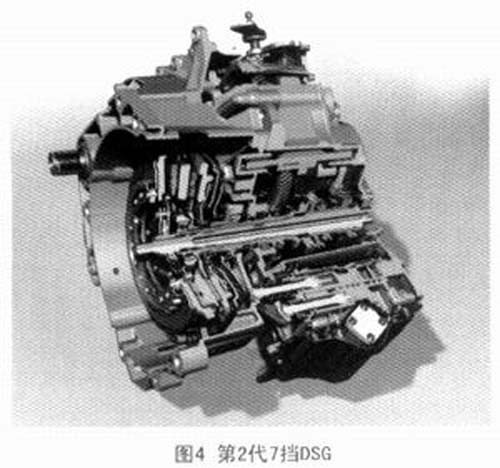Since February 2008, Volkswagen has been equipped with the second generation DSG on the golf series sedan (Fig. 4). The 2nd generation DSG added a forward gear on the basis of keeping the overall volume close to the 1st generation three-axis DSG; and replaced the wet clutches arranged side by side with two dry clutches arranged one behind the other. These two changes will help improve the economy of the car.

A comparison experiment with two 1.4-L golf cars equipped with the first-generation 6-speed DSG and the second-generation 7-speed DSG was shown (Table 1). The CO2 emission per 100km of golf cars equipped with 7-speed DSG Reduce 1kg; reduce fuel consumption by 0.4L.

2 Comparison of dry and wet clutches
During the shifting process, the DCT has two clutches that simultaneously slide and generate a large amount of heat. If the heat is not dissipated in time, the clutch will generate a local high temperature due to friction, which will cause the warping deformation or even sintering of the friction plate, which seriously affects the performance and life of the clutch. Therefore, the material of the clutch friction plate, the wear resistance, the friction coefficient and the oil groove design form of the friction surface are all key problems to be solved.
Dry clutches have the following advantages over wet clutches:
1) High transmission efficiency and good economy:
2) compact structure and light weight;
3) Low cost and low maintenance costs.
However, due to the poor thermal load performance and short service life of the dry clutch, the application of the dry clutch is limited. Therefore, the wet clutch was first applied to the 1st generation DSG product. Although the fuel consumption of the wet clutch DSG is 4%-6% higher than that of the dry clutch, and the drag torque is larger when the clutch is disengaged, additional energy loss is added. However, its good thermal load performance and long service life ensure that the DSG is put into use smoothly.
At present, the basis for selecting the clutch is to calculate the load performance and incorporate the calculation result into the load index: comprehensively consider the requirements of the efficiency, reliability, service life, fuel consumption and performance of the clutch, and the data and capability index will be tested. Compared. The capability index depends on the size of the clutch and is related to the cooling performance, thermal performance and wear of the clutch. Therefore, when selecting a clutch, not only must consider the decisive load factor and capacity factor, but also consider the engine power delivered by the clutch, and also consider whether there is enough space to accommodate (Figure 5). Studies have shown that dry clutches are the preferred choice for cars with output torques of 150-250 N·m.
Previous page next page
The DIY Magic Post Window Screen has revolutionized the way homeowners approach window screen installation. This innovative product offers a hassle-free and convenient solution for creating custom-fit screens without the need for tools or extensive expertise. The Magic Post Window Screen kit includes adjustable posts that securely hold the screen in place, eliminating the need for traditional frames or adhesives. With its user-friendly design, anyone can easily install or remove the screen in a matter of minutes. This DIY solution allows for optimal airflow, natural light, and protection against insects, making it an ideal choice for those seeking a quick and efficient way to enjoy bug-free ventilation in their homes.
DIY Magic Post Window Screen,Screen Window Net,Diy Insects Protection Window Screen,Anti Insects Netting
Jinwu Glass Fiber Co., Ltd , https://www.jwglassfiber.com